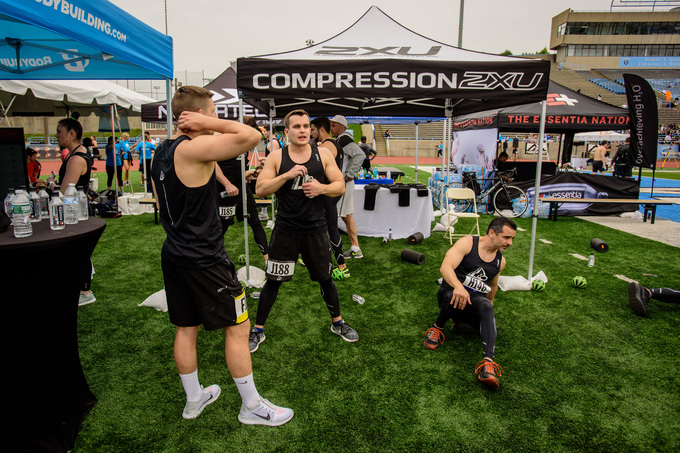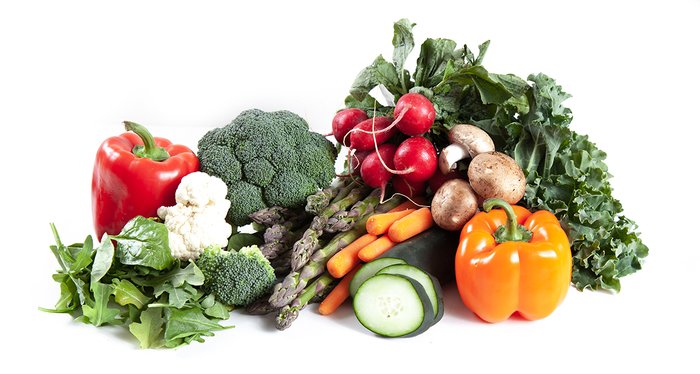Train With Purpose: Speed Your Recovery
August 16, 2018

Train With Purpose is a series brought to you in collaboration with Bodybuilding.com.
By: Jimmy Smith, MS, CSCS
Jimmy Smith is a certified strength and conditioning specialist (CSCS) and is routinely sought after to provide cutting edge, no-B.S. advice.
By: Jimmy Smith, MS, CSCS
Jimmy Smith is a certified strength and conditioning specialist (CSCS) and is routinely sought after to provide cutting edge, no-B.S. advice.
With the Internet at our fingertips, it's surprisingly easy to stay up-to-date on the latest research or find new and innovative training techniques to enhance muscle growth.
If modern technology has brought the latest training information to our fingertips, then it stands to reason we also have access to the best ways to enhance post-workout recovery.More often than not, however, the less glamorous recovery stories are often ignored in favor of flashy new workout variations or the latest and greatest fitness craze.
The challenge, it seems, is not access to the latest recovery information—the challenge is cutting through the noise to identify which of this on-demand information is useful.If you're like most readers, you've likely missed the most recent tips and techniques for speeding muscle recovery.
Here are four recovery-enhancing tips that are indispensable.
If modern technology has brought the latest training information to our fingertips, then it stands to reason we also have access to the best ways to enhance post-workout recovery.More often than not, however, the less glamorous recovery stories are often ignored in favor of flashy new workout variations or the latest and greatest fitness craze.
The challenge, it seems, is not access to the latest recovery information—the challenge is cutting through the noise to identify which of this on-demand information is useful.If you're like most readers, you've likely missed the most recent tips and techniques for speeding muscle recovery.
Here are four recovery-enhancing tips that are indispensable.
1. Show Your Micros The Same Love You Show Your Macros
By now, most people are familiar with macronutrients: protein, fat, and carbohydrates, including fiber. Unless you've been living under a rock these past few years, you also know that flexible dieting, aka If It Fits Your Macros (IIFYM), is a popular way to eat healthfully without weighing, measuring, and counting every calorie.Unfortunately for the IIFYM crowd, placing too much emphasis on macronutrients and very little on micronutrients (vitamins, minerals, phytochemicals) might be precisely where they are falling short.
While you may have initial success on any macronutrient-controlled diet, studies have shown that simply improving the quality of your food—with no changes in quantity—leads to an improvement in body composition. [notes 1,2]

Furthermore, the stricter a diet becomes—like when you're cutting down for a competition—the more micronutrients matter. The metabolic and hormonal consequences of reduced-calorie diets, combined with the increased activity of training for muscle growth or competition, ramp up the micronutrient demands of your hypothalamus and pituitary gland. [3]
Though it's tempting to fit junk foods into your meal plan, the increased micronutrient demand of training is precisely why serious athletes should choose varied and nutrient-dense foods to promote better muscle recovery and improve performance.
2. Optimize Carb Intake Before And After Workouts
Every informed reader knows about pre- and post-workout nutrition, but until you actually try to dial in your food intake during these critical windows, you won't truly reap the benefits of faster recovery and better performance.Training fatigue is directly dependent on the amount of glycogen already present in your muscles when you start working out, meaning the less glycogen you start with, the faster you will fatigue. This is why it makes sense to consume carbohydrates before you train to increase your glycogen stores. Just make sure to choose gut-friendly carbohydrates so you can train without GI distress.
I prefer gluten-free options for reasons I will discuss in the next section. My pre-training meal is usually organic honey on gluten-free bread or apple sauce. If you want to avoid added sugars and fructose, you could try mashed sweet potatoes instead. Whatever pre-workout meal you choose, make sure you prime your body for better performance and faster recovery by consuming your carbs before you lift.

While I won't go as far as to put a specific timeframe or amount on this ideal post-workout window, in the case of multiple workouts per day or consecutive daily workouts, I've found that placing around 50 percent of my daily carbohydrates after I work out has allowed me to more efficiently manage my recovery and reduce muscle soreness. [5]
An important note: Just because you increase your carb intake before and after your workout does not mean high-carbohydrate meals all day long is the way to go. On the contrary, post-workout is the only time your muscles can take up glucose with minimal release of insulin. Otherwise, your pancreas has to release insulin to shuttle glucose into tissues every time you eat carbohydrates.
Since the majority of us—even those who train intensely—are sedentary most of the day, eating high-carbohydrate meals throughout the day places unnecessary strain on our pancreas by requiring the frequent release of insulin to control blood sugar levels.This is why it's best to eat the majority of your carbohydrates either pre- or post-workout and minimize carbohydrate intake for the rest of the day.
3. Prioritize Digestive Health
Nothing sabotages your motivation faster than not being able to show off your results because you're bloated and gassy. Inflammation of your gastrointestinal (GI) tract manifests in a variety of physical symptoms, including rashes, bloating, digestive discomfort, and fluid retention in the gut. [6]Immunogenic foods (substances that produce an allergic response) include such staples as corn, soy, dairy, and gluten. Although only a small percentage of the population is allergic to these substances, a larger portion may simply be sensitive to them, which could in turn contribute to minor inflammatory GI issues. [7]

Stress to the digestive system can both decrease levels of thyroid hormone (needed for proper glucose uptake) and increase insulin resistance.[8] Even if you don't have any obvious gut issues, your GI tract might be stressed without you even realizing it, making it that much harder for you to build muscle or get lean.
Fitness competitors are often encouraged to adopt extreme, low-carb diets and do copious amounts of cardio to lean down. A safer, more effective solution might simply be removing inflammatory foods. If the end goal is better aesthetics, why tolerate bloating, calorie-restriction, and hours of cardio when it's far more beneficial—and easier—to simply avoid the digestive stress in the first place?
Anyone dealing with gut problems has a serious disadvantage when it comes to training and recovery. Since no one food causes inflammation in every person, you may have to experiment with eliminating different immunogenic foods until you discover what works best for you.

4. Sleep Like It's Your Job
Much of today's social media humor revolves around the desire to nap as much as possible. Yet, most people's daily habits sabotage both the quantity and the quality of their sleep.From overconsuming caffeine to staying up late staring at a screen to not optimizing sleep environments, many of us experience poor sleep. [9] While lack of sleep may not seem like a big deal, there are significant hormonal consequences after missing even one night of sleep.
Studies show sleep loss can interfere with metabolism by promoting higher levels of ghrelin, the so-called hunger hormone, and by decreasing insulin sensitivity and increasing inflammation and cortisol. [10,11]

If you want faster recovery and better athletic performance, make quality sleep a priority. Limit your exposure to blue light at night, supplement with relaxation-promoting nutrients such as magnesium, and create a cool, dark environment to sleep in.The more seriously you control the quality and quantity of your sleep, the more you'll see improvements in your hormonal signaling, including everything from increased libido and reduction in bloating to faster recovery and better performance in the gym.
The Faster Recovery Checklist
That was a lot of information, so here's a quick checklist to help you develop and implement these four faster-recovery habits:- Feed your body. Focus on food quality by choosing nutrient-dense foods.
- Take advantage of pre- and post-workout fueling opportunities and manage blood glucose levels throughout the day by planning your carbohydrate intake carefully.
- Improve gut health by eliminating immunogenic foods and increasing your intake of gut-friendly foods.
- Prioritize sleep every single night.
References
- Marriott, B. M. (1995). Effects of Food Quality, Quantity, and Variety on Intake.
- Gaesser, G. A. (2007). Carbohydrate quantity and quality in relation to body mass index. Journal of the American Dietetic Association, 107(10), 1768-1780.
- Smith, S. M., & Vale, W. W. (2006). The role of the hypothalamic-pituitary-adrenal axis in neuroendocrine responses to stress. Dialogues in clinical neuroscience, 8(4), 383.
- Richter, E. A., & Hargreaves, M. (2013). Exercise, GLUT4, and skeletal muscle glucose uptake. Physiological reviews, 93(3), 993-1017.
- Kerksick, C., Harvey, T., Stout, J., Campbell, B., Wilborn, C., Kreider, R., ... & Ivy, J. L. (2008). International Society of Sports Nutrition position stand: nutrient timing. Journal of the International Society of Sports Nutrition, 5(1), 17.
- Mu, Q., Kirby, J., Reilly, C. M., & Luo, X. M. (2017). Leaky gut as a danger signal for autoimmune diseases. Frontiers in Immunology, 8, 598.
- Pali-Schöll, I., Herrmann, I., Jensen-Jarolim, E., & Iben, C. (2017). Allergies, with Focus on Food Allergies, in Humans and Their Animals. In Comparative Medicine (pp. 109-129). Springer, Cham.
- Bischoff, S. C., Barbara, G., Buurman, W., Ockhuizen, T., Schulzke, J. D., Serino, M., ... & Wells, J. M. (2014). Intestinal permeability–a new target for disease prevention and therapy. BMC Gastroenterology, 14(1), 189.
- Bedrosian, T. A., & Nelson, R. J. (2017). Timing of light exposure affects mood and brain circuits. Translational Psychiatry, 7(1), e1017.
- Leproult, R., Holmbäck, U., & Van Cauter, E. (2014). Circadian misalignment augments markers of insulin resistance and inflammation, independently of sleep loss. Diabetes, 63(6), 1860-1869.
- Kim, T. W., Jeong, J. H., & Hong, S. C. (2015). The impact of sleep and circadian disturbance on hormones and metabolism. International Journal of Endocrinology, 2015.